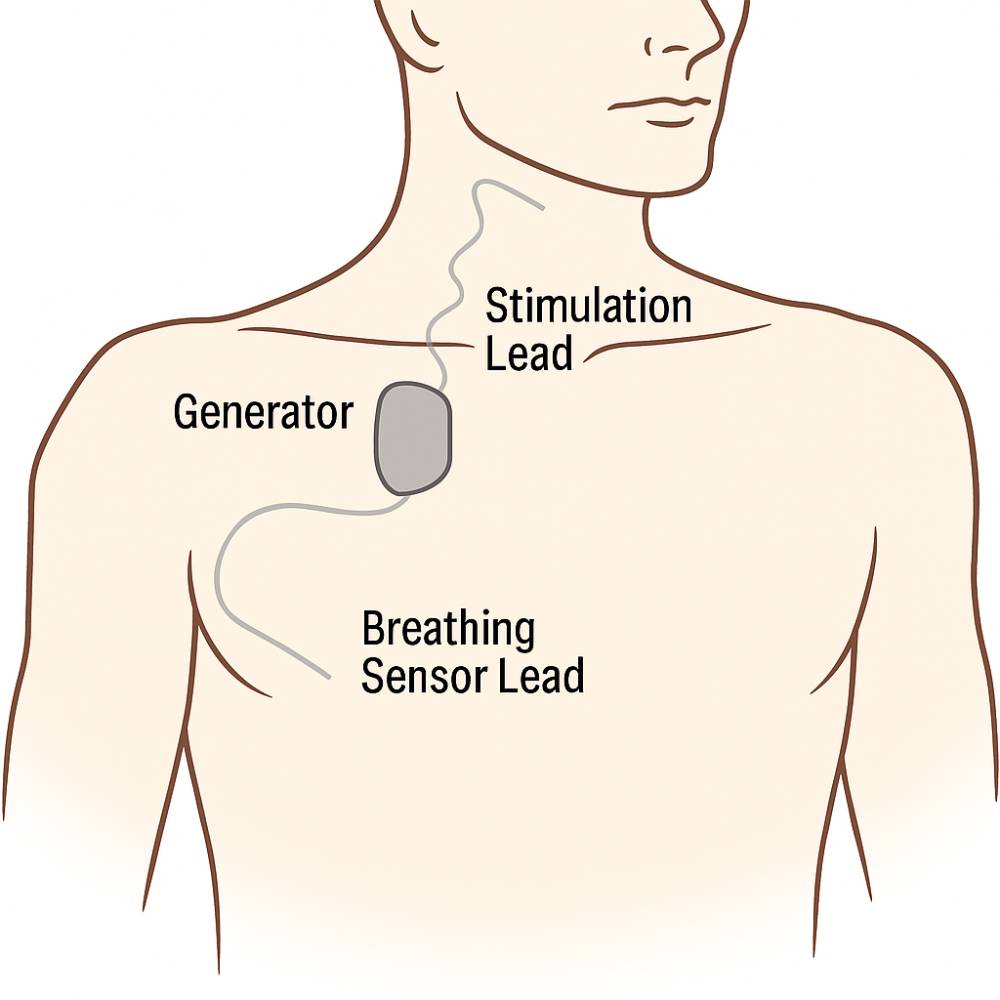Obstructive sleep apnea (OSA) is a common condition where the airway repeatedly collapses during sleep, leading to breathing pauses, poor sleep quality, daytime sleepiness, and long-term health risks, including cardiovascular disease. While continuous positive airway pressure (CPAP) therapy is effective for many, not all patients can tolerate it. Inspire implants aim to be an alternative for treating OSA, providing a solution for those who struggle with conventional therapies.
Inspire implants, or hypoglossal nerve stimulation devices, are surgically implanted devices designed to treat moderate to severe OSA. These devices work by stimulating the hypoglossal nerve, which controls the tongue muscles. By stimulating this nerve during sleep, the implant helps prevent airway collapse and maintains normal breathing. The device is activated with a handheld remote, allowing the patient to turn it on at bedtime and off in the morning.
The Inspire system consists of three components: a pulse generator, a sensing lead, and a stimulation lead. The pulse generator is implanted under the skin in the chest, while the sensing lead monitors the patient’s breathing patterns. The stimulation lead is placed near the hypoglossal nerve and delivers mild electrical pulses to stimulate the tongue muscles. As the patient sleeps, the sensing lead detects breathing patterns and identifies when the airway is at risk of collapsing. The pulse generator then signals the stimulation lead, causing the tongue muscles to contract and keep the airway open. This stimulation continues throughout the night, ensuring uninterrupted breathing 3,4.
A key benefit of Inspire implants is that they offer a solution for patients who cannot tolerate CPAP therapy. Many patients find CPAP uncomfortable and struggle, with mask discomfort, air leakage, or difficulty adjusting to the constant airflow.
In addition to improving sleep quality, Inspire implants have been shown to reduce daytime sleepiness and improve overall quality of life. Clinical studies have reported significant improvements in sleep apnea severity and reductions in the frequency of apneas and hypopneas. Many users also experience increased energy and improved mood 5–7.
Inspire implants are typically recommended for patients with moderate to severe OSA who cannot tolerate CPAP or other treatments. Ideal candidates are generally not excessively overweight and do not have medical conditions that may interfere with the procedure or recovery. Before implantation, patients undergo a comprehensive evaluation, including a sleep study and consultation with an ear, nose, and throat (ENT) specialist to assess candidacy 8,9.
While Inspire implants are generally safe, some risks and complications may arise, including but not limited to infection at the implant site, discomfort around the device, or malfunction 10,11.
By directly stimulating the muscles controlling the tongue, Inspire implants help prevent airway collapse and promote better sleep, offering a promising alternative for patients with OSA who cannot tolerate CPAP.
References
1. Inspire Therapy for OSA NYC | Mount Sinai – New York. Mount Sinai Health System https://www.mountsinai.org/care/ent/services/sleep-surgery/inspire-therapy.
2. Understanding Inspire Sleep Therapy | How Inspire for Sleep Apnea Works | Cleveland, Ohio | University Hospitals. https://www.uhhospitals.org/services/ear-nose-and-throat-services/conditions-and-treatments/inspire-therapy-for-obstructive-sleep-apnea/how-it-works.
3. How Inspire Therapy Works | Inspire Sleep Apnea Innovation. https://www.inspiresleep.com/en-us/how-inspire-therapy-works/.
4. Hypoglossal Nerve Stimulation Implant for Sleep Apnea. https://www.hopkinsmedicine.org/health/conditions-and-diseases/obstructive-sleep-apnea/hypoglossal-nerve-stimulation (2023).
5. Inspire Sleep Apnea Innovation – Obstructive Sleep Apnea Treatment. https://www.inspiresleep.com/en-us/.
6. Baptista, P. et al. Quality of Life Impact of Hypoglossal Nerve Stimulation with Inspire® Device in Patients with Obstructive Sleep Apnea Intolerant to Continuous Positive Airway Pressure Therapy. Life (Basel) 12, 1737 (2022). DOI: 10.3390/life12111737
7. Unmasking the Benefits of Inspire vs. CPAP Helps Medina Woman. Cleveland Clinic https://my.clevelandclinic.org/patient-stories/738-unmasking-the-benefits-of-inspire-vs-cpap-helps-medina-woman.
8. Inspire Therapy | The University of Kansas Health System. https://www.kansashealthsystem.com/care/treatments/sleep-apnea-surgery/inspire-therapy.
9. Inspire Therapy Qualification Requirements | Inspire Sleep Apnea Innovation. https://www.inspiresleep.com/en-us/qualification-requirements/.
10. Bestourous, D. E., Pasick, L. J., Benito, D. A. & Zapanta, P. E. Adverse events associated with the Inspire implantable hypoglossal nerve stimulator: A MAUDE database review. American Journal of Otolaryngology 41, 102616 (2020). DOI: 10.1016/j.amjoto.2020.102616
11. Important Safety Information | Inspire Sleep Apnea Innovation. https://www.inspiresleep.com/en-us/safety-information/.
